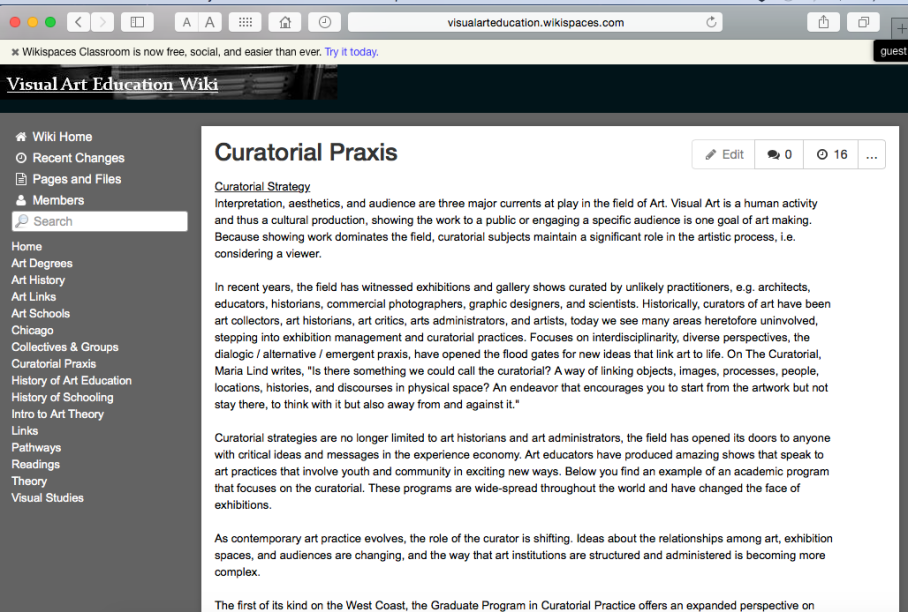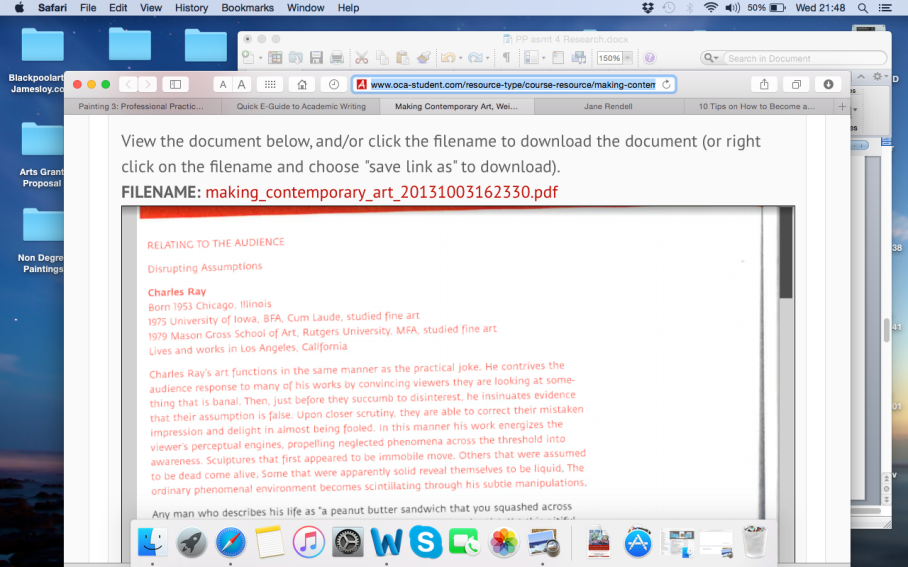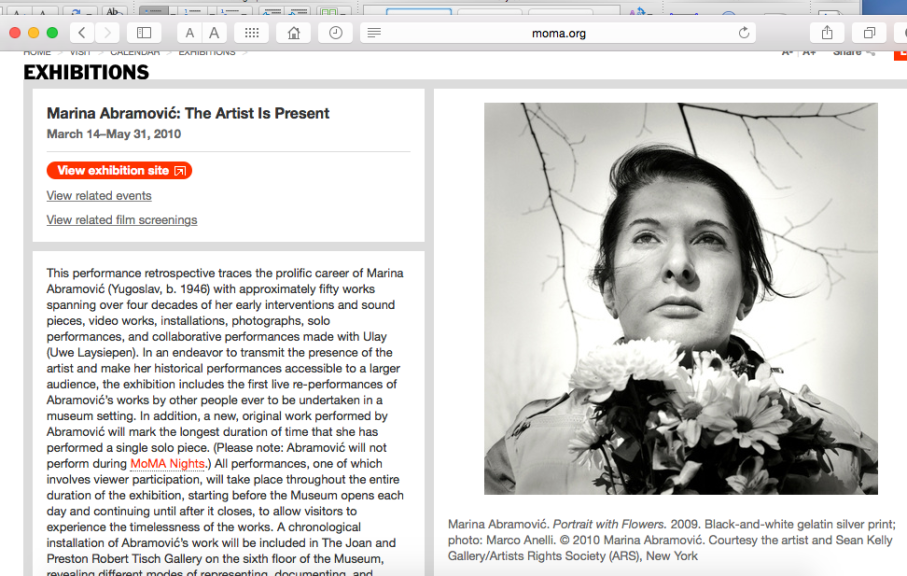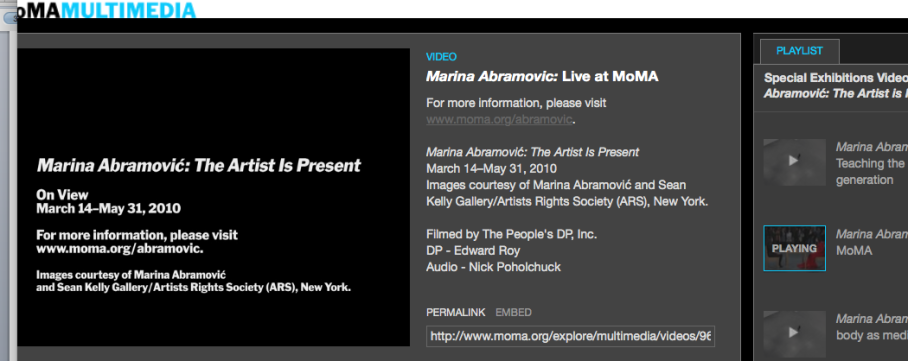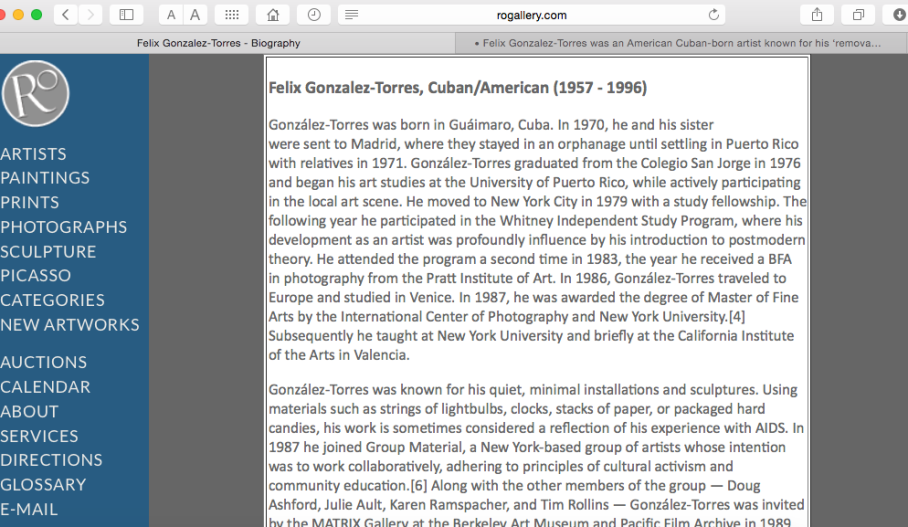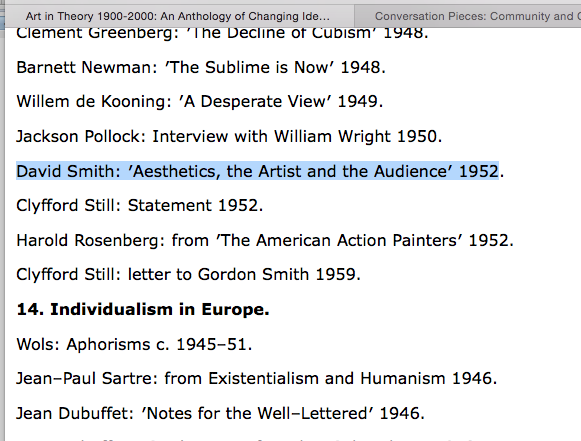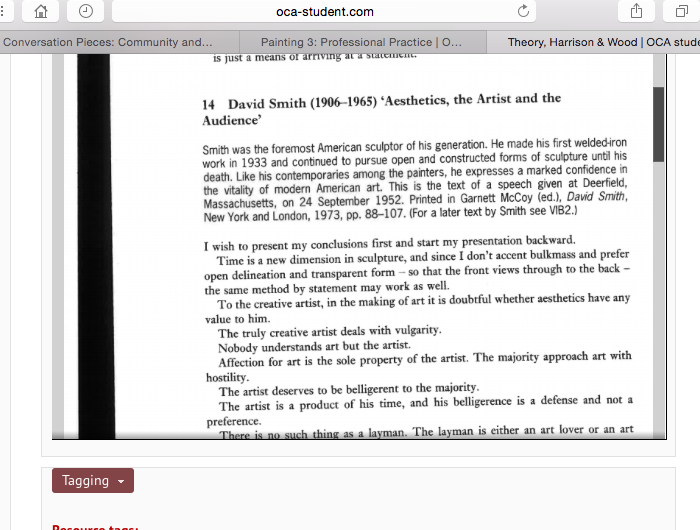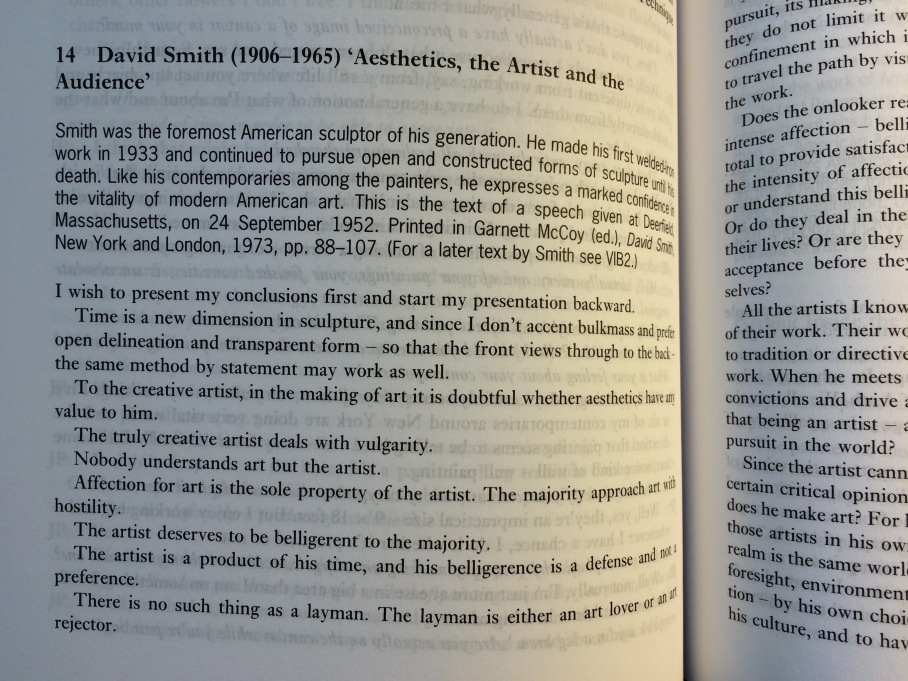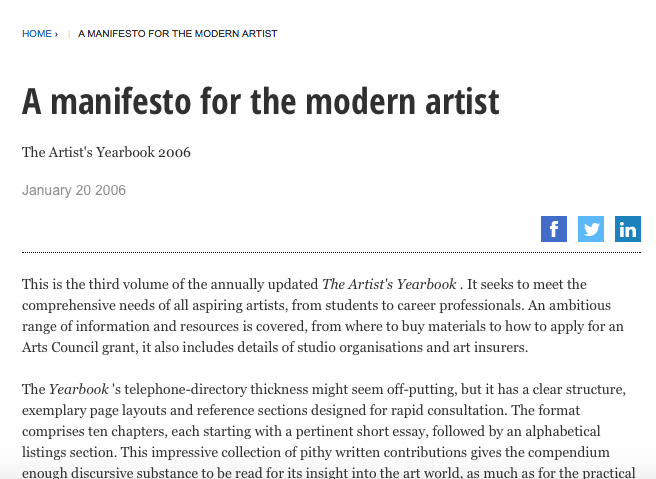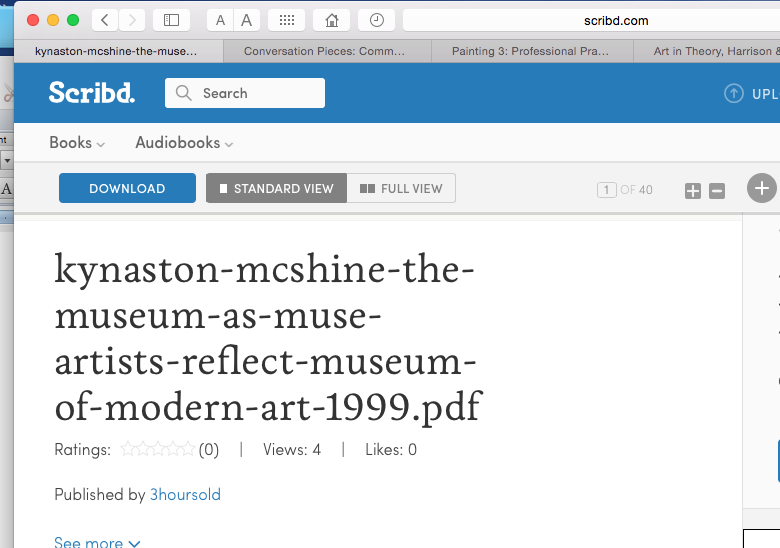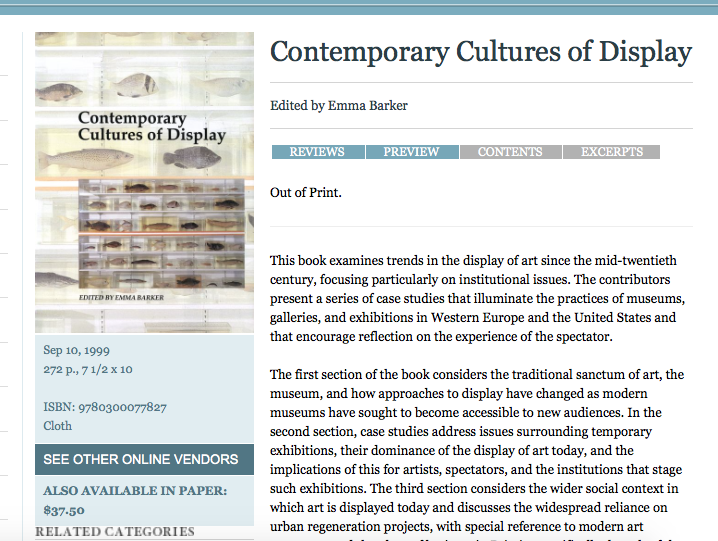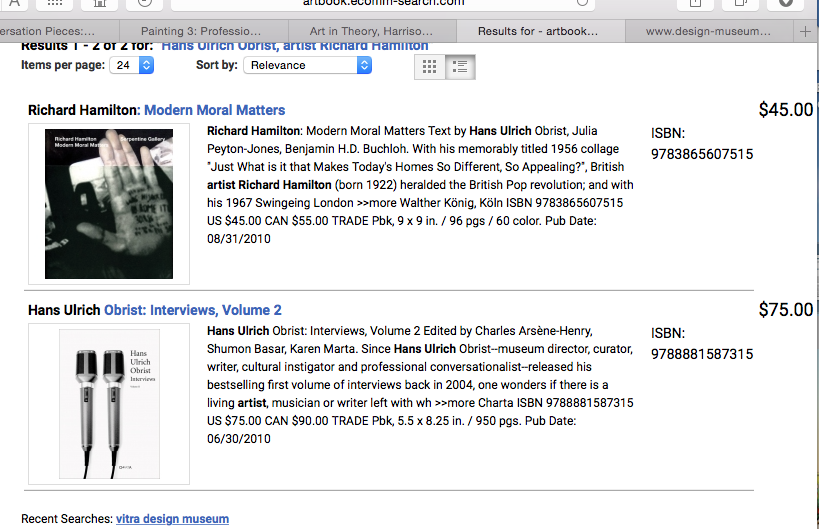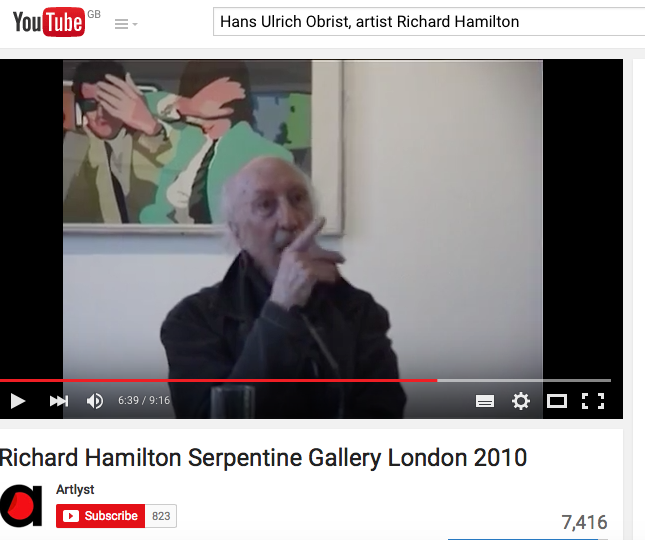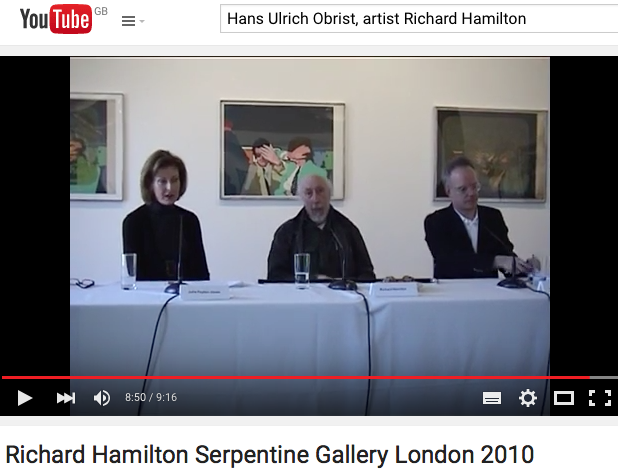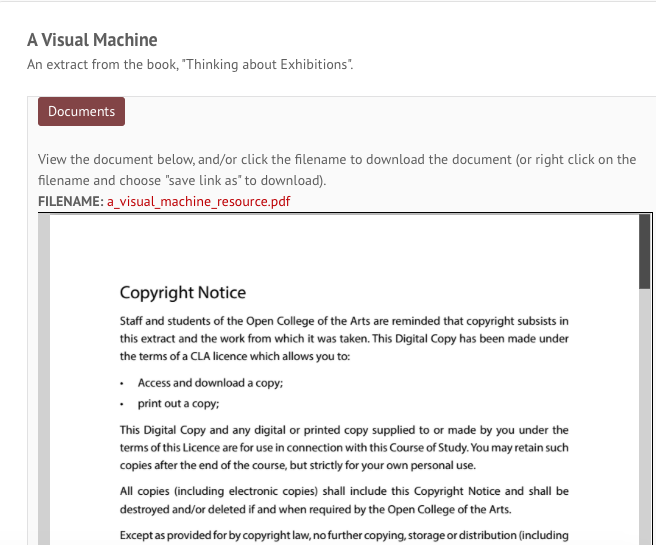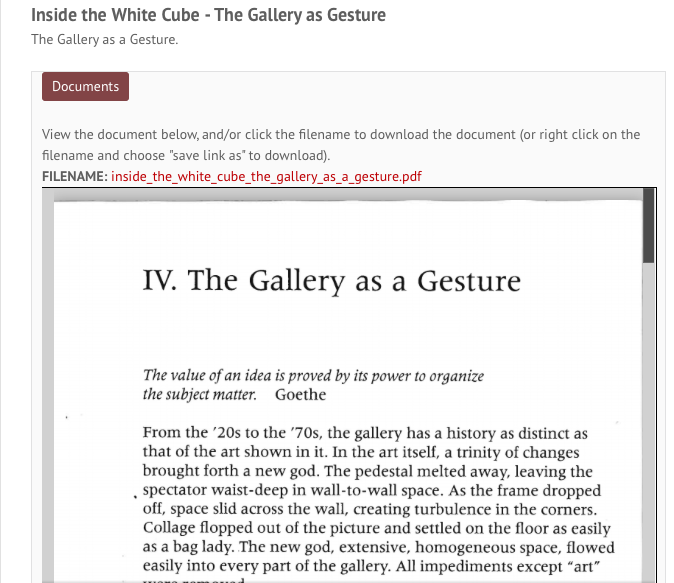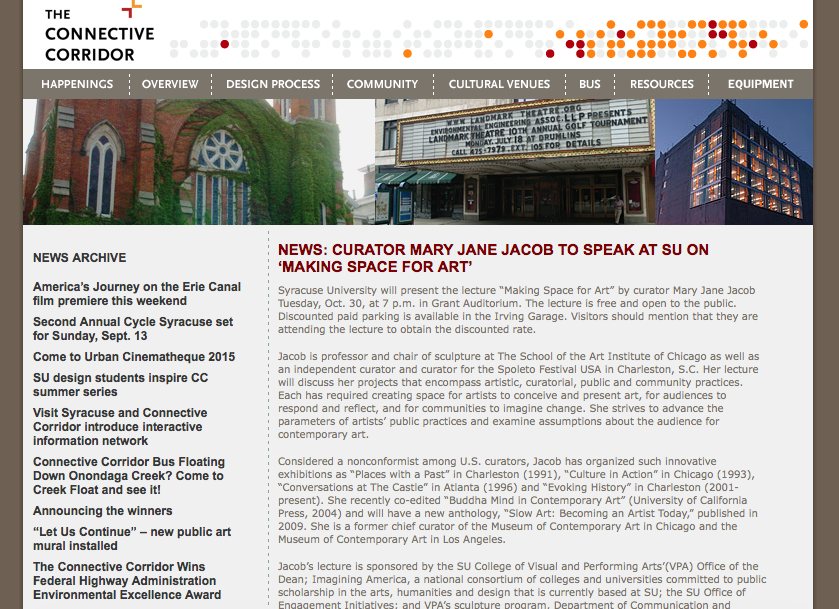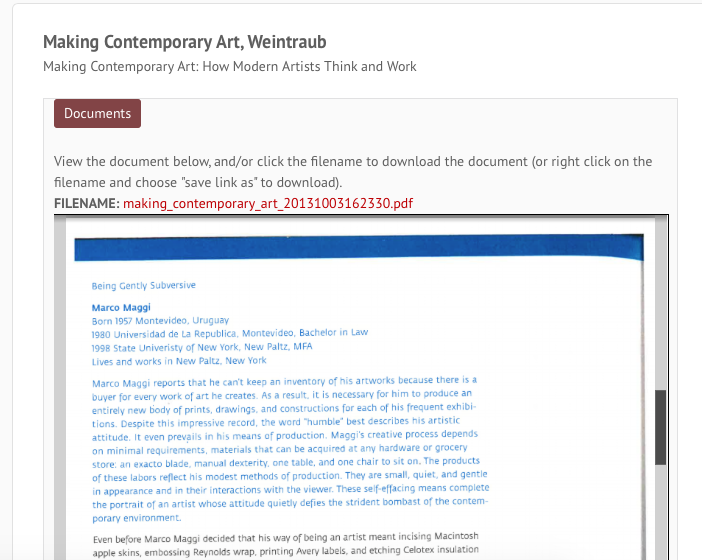PP asmt 4 Research
I have read through the links on the assignment and noted down my findings in this document. I found that the best way to do this was to copy and paste all the areas of research instructions from the course pdf into the document then work through them all step by step. I can keep going back to the document when I have the time to research. The system works for me but it may not suit all students. I see it as putting all similar things in one drawer together instead of spreading them out in different drawers. A bit like how I would arrange my tools in my tool box (when I used to work with a tool box) or how one would arrange ones clothes in a chest of drawers or how I arrange my acrylics (when they are not in use) all the reds together, all the yellows and browns together, greens and blues and so on.
“Interpretation, aesthetics, and audience are three major currents at play in the field of Art.”
http://visualarteducation.wikispaces.com/Curatorial+Praxis
Read this useful information for setting up my gallery space and consider the major strands, interpretation, aesthetics and audience. I mostly call them the viewers – same thing. If I was dancing on stage I would be more comfortable with audience but when I am not around standing in front of my work I prefer ‘viewer’.
When you’re curating an art show you need to understand the intricate structural mapping of your exhibition.
Useful resources:
- Jane Rendell ‘Critical Spatial Practice: Curating, Editing, Writing’ in Rugg, J. & Sedgwick, M. (2011) Issues in Curating Contemporary Art and Performance. Bristol: Intellect Books (pp.59–76). (You’ll find this chapter on the student website.)
http://www.oca-student.com/resource-type/course-resource/issues-curating-practice-discourse
http://www.janerendell.co.uk/wp-content/uploads/2013/02/Curating-Editing-Writing-….pdf
- Paul O’Neill (2007) Curating Subjects. London: Open Editions.
http://www.pauloneill.org.uk/curatorial/research/curating-subjects/
The audience
“A curator is not a creator but a facilitator for both the audience and the artists and a messenger who delivers ideas from contemporary society. A good curator needs to understand the audience and to fully communicate with the artists to let their work speak out to the public.”
Curator Kwanyi Pan, quoted by Susan Kendzulak, 2013.
http://fineart.about.com/od/Curator/ss/Curating-A-Show-In-10-Easy-Steps-A-Step-By-Step-Guide-For-Art- Curators_3.htm
Well this sums it all up on how to put on a professional exhibition.
It has been worthwhile piece of easy reading and I can glean many ideas, some of which I have already used.
Useful resources:
- Charles Ray ‘Disrupting Assumptions’ in Weintraub, L. (2003) Making Contemporary Art: How Today’s Artists Think and Work. London: Thames & Hudson (pp.76–85). (You’ll find this chapter on the student website.)
http://www.oca-student.com/resource-type/course-resource/making-contemporary-art-weintraub
Disrupting assumptions becomes simplified when reading about how Charles Ray works with his sculptures and his mind. If it were not for his mind he would never have been able to think all these things out. We are all connected to time, how boring is that? Good job we have something to fill out our time; (thinking of Clock Man 1978).
Useful resources:
The following artists have involved their audience in some way to the point that their work would not exist if it were not for the audience.
- Graham Coulter-Smith installationart.net/Chapter4Recombination/recombination06.html
http://www.installationart.net/Chapter4Recombination/recombination06.html
- Marina Abramovié is a Serbian performance artist and one of her main concerns is investigating and playing with the audience and the artist’s relationship with it. As a starting point, research her most recent experiment, ‘The Artist is Present’, and make notes on how the relationship with an audience member can be seen as art within a space. Is this relationship about the space or the work?
What do I think the relationship between a member of the audience and the art in the gallery space depends upon? It depends what the artist is trying to achieve with their art. All artists want the audience to take away some kind of knowledge and experience to make the process worthwhile for the artist who puts in the hard work creating the work, which is worthless to the general public if an audience does not see it.
Some artists go further and invite the audience into their work to ‘transmit the presence of the artist’ and without that audience being present the work is useless, either because the audience is not interested to participate or there is no audience. Abramovic’s work involves the use of installation, solo performance, video, photographs and sound pieces. So by being a performance artist the artist on stage as it were has the opportunity to create something in public, which cannot be performed, in private life. This is the opposite of making a painting where the painting is usually done in private and unveiled to the public when It is completed. The performance artist is doing their art in public where it is made and there is no art being made in private.
There is space in my exhibition in the centre of the room where I might start painting the abstract versions of my last series of stray dogs in Thailand as a form of performance/private art. A ‘sat on the fence’ work for a future audience to view.
The MOMA videos are very informative on this exhibition. Mariana wants to leave behind a good idea to audience of all ages and one that can be performed by others in a way of passing on the message to future generations.
- Felix Gonzalez-Torres was an American Cuban-born artist known for his ‘removable’ installations made of everyday items.
Felix Gonzales-Torres was known as a process artist because of his removable installations where the audience would enter the gallery and be invited to take away a piece of the installation. If the installation was a pile of candies as sculpture remove some pieces was like eroding the sculpture.
I once saw an exhibition at the Tate Liverpool where the artist had piled some A0 size black and white prints of the tide on a sea coastline. The audience was allowed to take away as many sheets as they wished and when the pile was finished a new pile of sheets were brought into the space for the same process to begin again. The idea was to signify the tide going out and coming in again.
- Useful resources:
- David Smith ‘Aesthetics, the Artist and the Audience’ (1952) in Harrison, C. and Wood, P. (eds.) (2003) Art in Theory 1900–2000: An Anthology of Changing Ideas, Oxford: Blackwell (pp.586–88). (You’ll find this article on the student website.)
David Smiths philosophy is valid and interesting it brings out the thoughts in an artists mind which are there to begin with but are not realized more clearly until they are discussed and agreed upon. As Smith finishes in his statement, which could also have been at the beginning of his statement, “neither artist nor audience can deal with concepts that are not nature”
David Smith ‘Aesthetics, the Artist and the Audience’ (1952) in Harrison, C. and Wood, P. (eds.) (2003) Art in Theory 1900–2000: An Anthology of Changing Ideas, Oxford: Blackwell (pp.586–88).
A page from my own research book Art in Theory.
- The space as art
- “Spaces can be playgrounds, cruising destinations, laboratories, political platforms, temples of worship, black boxes or white cubes.”
- Iwona Blazwick, The Artists’ Yearbook, 143
‘The most important woman in British art’.
A very interesting read I could use some of the tips on applying for funding an art exhibition hence the reason why I spent so much time on my last assignment attending all the free workshop lessons on starting out as a freelancer, golden rules of proposal making, grants for the arts surgery, navigating the art world and managing a project.
- Further resources:
- McShine, K. (1999) The Museum as Muse: Artists Reflect. New York: MoMA.
Artists on museums where the verbal compliments the visual as they must go hand in hand which is why so many artists become curators if not of their own work then as curators for other artists’ work.
Barker, E. (ed.) (1999) Contemporary Cultures of Display. New Haven/London: Yale University Press/Open University.
http://yalepress.yale.edu/book.asp?isbn=9780300077827
- Creating dialogue between the works
- In an interview with Hans Ulrich Obrist, artist Richard Hamilton commented that ‘We only remember new ways of exhibiting’ (see design-museum.de/en/information/texts- interviews-and-vidoes-from-the-vitra-design-museum/detailseiten/hans-ulrich-obrist.html).
Hans introduces Richard to talk about his involvement with Pop Art and as you can see in the background the painting with Mick Jagger in hand cuffs from a news reporters photograph as seen earlier in the video. The colours are applied as a form of camouflage and are as effective as the original image.
Further resources:
- Germano Celant ‘A Visual Machine: Art Installation and its Modern Archetypes’ in Greenberg, R. et al (1996) Thinking about Exhibitions. London: Routledge (pp.260–70).
As Germano Celante states ‘there cannot be any one norm’ in art and how it is displayed. I concur with the method of thought that certain subjects go together such as fashion with art – they both change and if one is out of sync with the other it will be the greater of the two that prevails.
- O’Doherty, B. (2000) Inside the White Cube: The Ideology of the Gallery Space, Berkeley/ Los Angeles: University of California Press, Chapter 5: The Gallery as Gesture (p.87). (You’ll find both of these on the student website.)
An interesting article on ‘gesture’ how new art is portrayed in many ways to tie the audience up in knots, binding them to the sea of thoughts that drown a viewer interested in finding new knowledge or new ways of displaying this knowledge. The title of an exhibition is all-important in getting across a message and then if the message fails to convey the meaning the game is lost.
When I went on the art course called ‘Dodge the Shredder’ there was a participant on the course who thought the course would remove all his paperwork on applying for funding. No chance of that, the course described how to apply for funding but the paperwork still had to be done. Consequently the participant left with some misunderstanding about what he had enrolled for. Getting the title right matters.
Further resources:
Mary Jane Jacob, Making Space for Art: Working with Artists. http://www.maryjanejacob.org/sub_pages/writings/writing_curating/making_space.html
- Marco Maggi, ‘Being Gently Subversive’ in Weintraub, L. (2003) Making Contemporary Art: How Today’s Artists Think and Work, London: Thames & Hudson (pp.270–79). (You’ll find this on the student website.)
http://www.oca-student.com/resource-type/course-resource/making-contemporary-art-weintraub
I am beginning to understand some of the arguments Maggi talks about.
When you look at something so finite on smooth clean surfaces and compare it with the rest of the world where things around us are a mess and totally cluttered then his work knocks your mind down to a different change of gear.
As he says ‘lower our voices and the ceilings of the art gallery’.
His world is more fragile than the real world.

